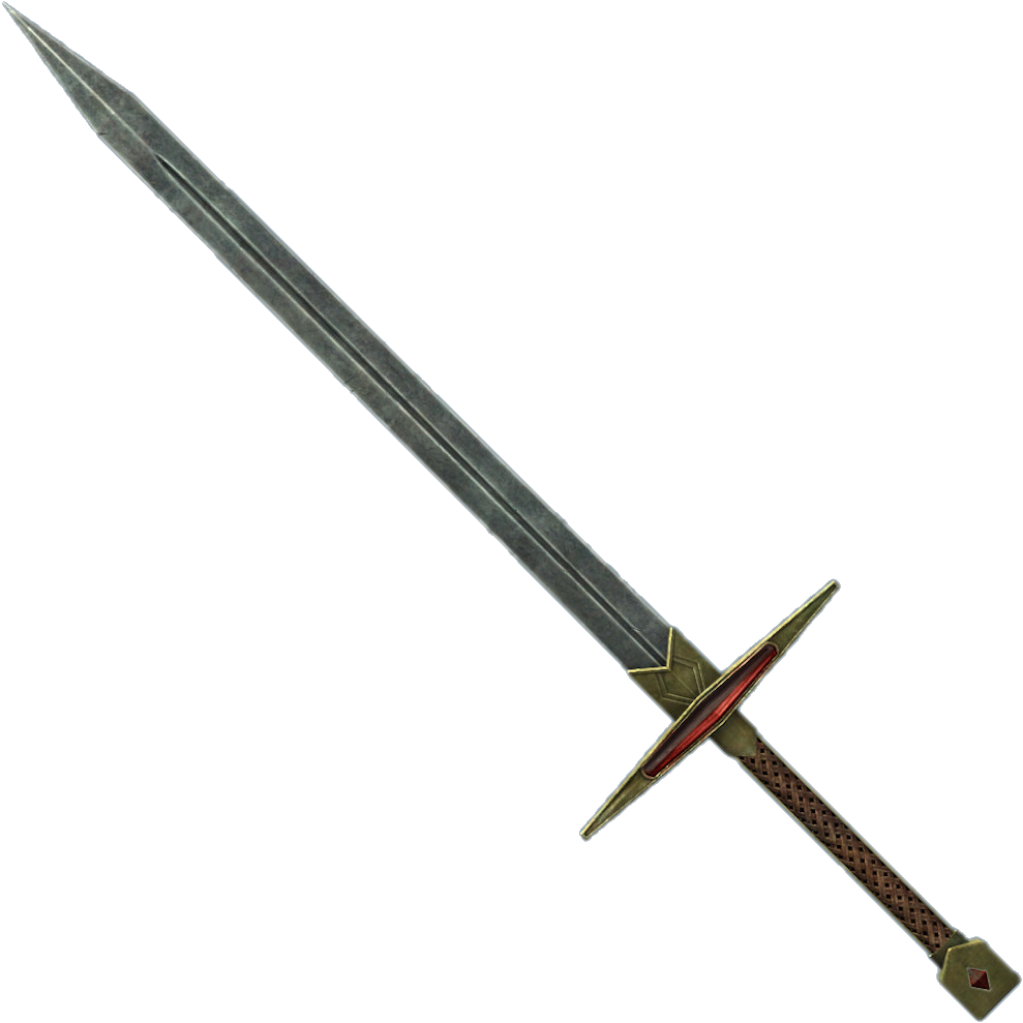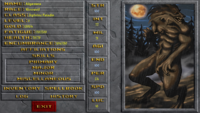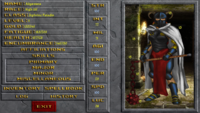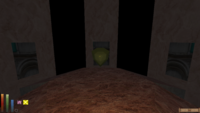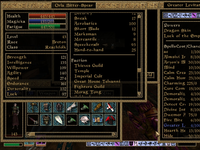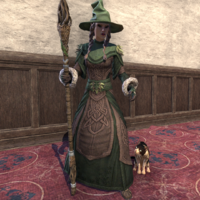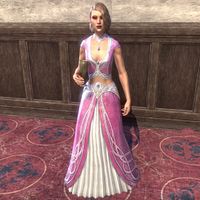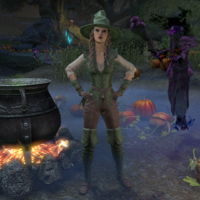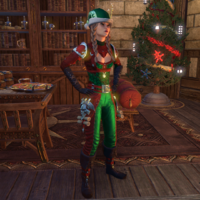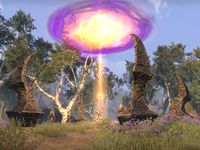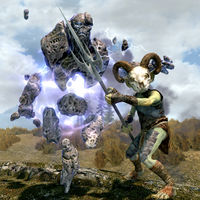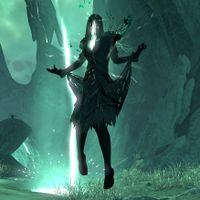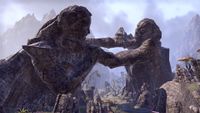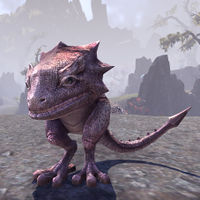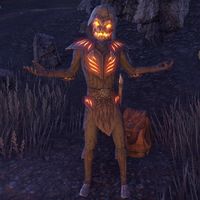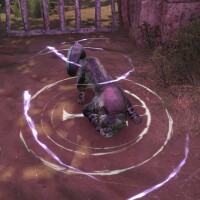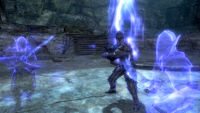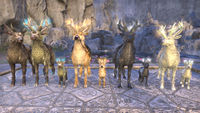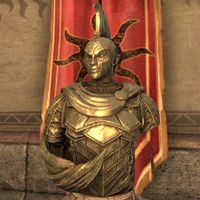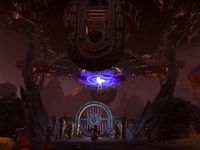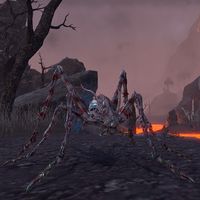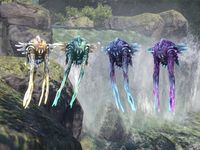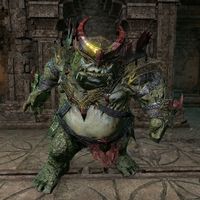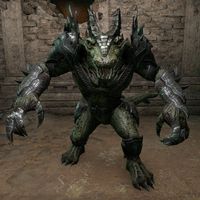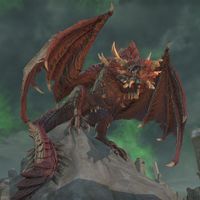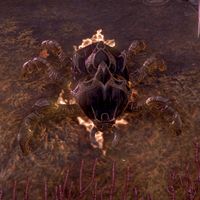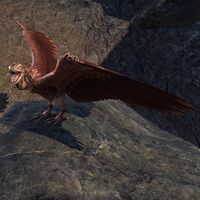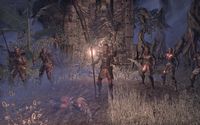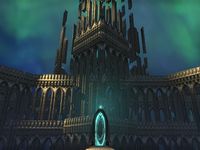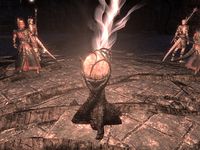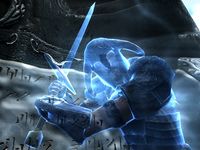User:Analeah Oaksong
Contents
- 1 Userboxes
- 2 Characters
- 3 Articles
- 3.1 Featured Articles
- 3.1.1 Lore:Hircine (28 March, 2021 - 28 April, 2021)
- 3.1.2 Lore:Breton (28 April, 2021 - 16 August, 2021)
- 3.1.3 Lore:Clockwork City (19 March, 2022 - 13 July, 2022)
- 3.1.4 Online:Volendrung (3 February, 2023 - 20 April, 2023)
- 3.1.5 Lore:Druids (20 April, 2023 - 20 June, 2023)
- 3.1.6 Lore:Mehrunes Dagon (20 June, 2023 - 27 September, 2023)
- 3.1.7 Lore:Chrysamere (30 September, 2024 - 11 November, 2024)
- 3.2 Other Notable Articles
- 3.1 Featured Articles
- 4 Images
- 5 Transcriptions
- 6 Answered Loremaster Archive Questions
Hello and welcome to my userpage. I am someone that enjoys spending some of my time creating or updating lore articles so that knowledge on the setting will be up to date for The Elder Scrolls community. I have a tendency to hyperfixate on certain topics. At the moment, that is currently Bretons and anything in proximity to their lore. I am also an enjoyer of the Daedric Prince Hircine.
I started playing Elder Scrolls games at roughly the age of 7. Morrowind was the first one I experienced, and honestly the lack of a quest marker helped develop my reading skills in order to understand the quest journal so I can get to the next quest objective. However, I wouldn't finish it until I would revisit it many years later and understood its game mechanics better. The first Elder Scrolls game I finished was Oblivion when I was around 10. Oblivion was just stupid fun and some of the dated game mechanics I interpret as part of its charm. Skyrim is just around the time I became invested in the series and the lore as a whole. I'd later visit the older games like Arena where I got stuck in a save file where I would die as soon as I left a dungeon due to a disease a Ghoul gave me (still haven't completed Arena), and Daggerfall which I finished thanks to Daggerfall Unity. ESO has taken up the majority of my Elder Scrolls playtime, thanks to it being an MMO in nature, and it having contributed to new additions to the lore over the decade that it has existed.
Overall, I thank the Elder Scrolls game for being a nice setting for its escapism it provides. I enjoyed Morrowind the most because it feels like an Isekai and least reminiscent of the real world, and I wished future entries leaned more into that vibe. Ironically, Bretons are my favorite race even if they are familiar and fulfill the role of being the medieval race of The Elder Scrolls universe. I really want a Breton mage that is on the same level of magical prowess as Divayth Fyr and Shalidor. Please give us one as Bretons are known for their mages. I believe that Elder Scrolls games should at least be enjoyed in at least one playthrough without any mods (with some exceptions like UI improvements) to see how the game was made in its original developer vision. Thanks to the modders that help extend the lifespan of Elder Scrolls games long past its release.
Userboxes[edit]
| This user plays on a Windows PC. |
| This user has made a grand total of 25,656 edits in 2426 days. |
| This user has been on UESPWiki for 6 years, 7 months, and 22 days. |
| This user is a Userspace Patroller. |
Characters[edit]
I have a completionist min-max playstyle, but gameplay decisions I make to get the best items or 100% a game that do not fit my character I do not treat as canon to my character's story.
Daggerfall
Records show many conflicting accounts on the hero Aliyavana, better known as "the Agent". Subject may have been involved in the Warp in the West caused by the Numidium, and may have inadvertently been one of its victims. Some prior-existing records giving more insight on her were overwritten simply with a "NO", and then they vanished from reality as if they never existed in the first place.
| This character is a member of the Altmer race. |
| This character worships Jephre. |
| This character worships Phynaster. |
| This character was born under the sign of The Lover. |
Morrowind
Orla Bitter-Spear (or Oriane Lacroix) was a hero born circa 3E 389 in some insignificant village near Jehanna in the Western Reach to uncertain parentage. It housed a Breton majority for its population, and she was given the name Oriane Lacroix by the local orphanage as her birth name was unknown. Her village was destroyed and its inhabitants slaughtered by raiders from Skyrim towards the beginning of the War of the Bend'r-mahk circa 3E 397. A band of roaming Reachmen discovered her in the aftermath, near Nordic mercenaries she rendered harmless with a well-timed paralysis spell. Impressed, the Reachmen invited Oriane to their home in the Wrothgarian Mountains, where she took on the name Orla, learned their lifestyle, and how to use their advanced hedge magic. On her 18th birthday circa 3E 407, she tracked and then killed a pale sabretooth tiger that had evaded and killed many of her clan. However, she had used up all her stamina on this effort, and she collapsed when she was unable to escape the blizzard that had enveloped her suddenly. She awoke safely in her clan's camp where her wounds were tended to, and seemingly gained Hircine's favor and his Spear of Bitter Mercy rested among her belongings. This spear would be used as the basis of her byname.
Orla's time among the Reachmen would come to an end, seemingly brought about by the questing culture inherent within her Breton blood. Much of her time afterwards is shrouded in myth. Some say she went eastward to steal the secrets from the Clever Folk of Skyrim. Others say she traveled deeper into High Rock to learn more from her Breton heritage, while seeking to become stronger. Others say these do not necessarily contradict, and she may have visited most of Tamriel's provinces to make as many significant memories as she could. At some point Hircine retook his spear, and Orla sought to win back his favor. She visited the City of a Thousand Cults, the Imperial City, where she created a cult dedicated to the worship of Hircine. It had combined the Reachmen belief of Hircine being the Lord of the Arena, Druidic beliefs of him representing the importance in nature of life and death between hunter and prey, and him being an ancient father figure similar to pre-ri'Datta Khajiiti beliefs. While daedra worship was considered an acceptable blasphemy under the Third Empire, the cult became too popular to be manageable, and she ended up in the Imperial Prison under the guise of disturbing the peace. She was then transported to the east, to Morrowind circa 3E 427.
Orla was tasked by Emperor Uriel Septim VII to fulfill the conditions of the Nerevarine Prophecy. She became a member of the Blades, with conflicting accounts stating she also joined other organizations like the Mages or Fighters Guild, with other accounts not agreeing on which mutually exclusive Great House she became a member of. She also forged significant bonds among the Ashlander tribes, whose lifestyle vaguely reminded her of the Reachmen back home. Regardless, she became the Hortator that united the Great Houses like Nerevar in ages past, and used Kagrenac's Tools to release the Heart of Lorkhan from the mortal plane. With Dagoth Ur gone and the Sixth House left in remnants, their threat slowly faded. During her adventures in Mournhold, she also discovered Sotha Sil's murder and disposed of Almalexia at the Clockwork City after uncovering her plot. On Solstheim, Orla partook in the Bloodmoon Prophecy and participated in the Hunter's Game, defeating her master Hircine and earning his favor and his artifact. Some say that she went to the east to Akavir, while others believed she went with Hircine to the Hunting Grounds, and that she would return to fight alongside him in the "end of all days" as a champion of the world of flesh.
| This character is a member of the Breton race. |
| This character is culturally a Reachmen. |
| This character worships Hircine |
| This character was born under the sign of The Lady. |
Oblivion
Skyrim
Allene Ashcroft was Breton born in the city of Mir Corrup circa 4E 179. From a young age, she could occasionally hear chanting seemingly coming from the far north, which had finally reached its climax after visiting family friends in Bruma circa 4E 201. Though she was raised far from High Rock, Allene was fascinated with her race's questing culture and was delighted upon learning that her family long ago laid its roots in ancient Nibenay by being among the Breton mercenaries given rich lands in exchange for aiding the Alessian Slave Rebellion. She had spent a significant part of her youth fulfilling Fighters Guild contracts and feeling confident with the skills she gained from the guild, she followed the chanting and crossed the border into Skyrim, where she fell into an ambush the Imperial Legion had intended for Stormcloak rebels.
Thinking she was an enemy, the Imperial Legion almost executed her over this misunderstanding. She escaped during the chaos caused by Alduin the World Eater's arrival and subsequently became involved in fulfilling the Prophecy of the Dragonborn. With the assistance of the Blades and the Greybeards, she fulfilled her destiny by stopping the dragon threat and slaying Alduin. She also stopped the plot to enact the Tyranny of the Sun, which would have plunged the world into eternal darkness, and then and journeyed to Solstheim to stop the return of Miraak, the First Dragonborn.
| This character is a member of the Breton race. |
| This character worships Shandar. |
| This character was born under the sign of The Lord. |
ESO
Analeah Oaksong was a Bosmer hero of mixed heritage active during the times of the Interregnum that was born to a Breton father and Bosmer mother circa 559 in Tamarilyn Point. A year later, the Knahaten Flu started ravaging Tamriel, which eventually made its way into High Rock and claimed the Gardner Dynasty of Wayrest circa 2E 563. When the illness took Analeah's father, her mother fled with her away from civilization to the west to be live in isolation among the Beldama Wyrd. She grew up there and learned their secrets on how they tap into the power of the Wyrd Tree, whose roots are spread through the world. When her mother passed, she was left with a memento, an idol of Tamarilyn Point's goddess of flowers, Druagaa, whose faith was slowly dying. When the Three Banner's War engulfed Tamriel, she enlisted into the forces of the Daggerfall Covenant, where she learned various skillsets required to survive in Tamriel. At some point, Analeah was kidnapped by the Worm Cult while visiting Daggerfall, and ritually sacrificed by Mannimarco, who inadvertently created the instrument that would be his downfall, the Vestige. After escaping from Coldharbour, she aided in putting down threats within Daggerfall Covenant territory like the Bloodroot Cult in Glenumbra, and the Supernal Dreamers in Stormhaven. There, she earned the friendship of High King Emeric, and aided him with the Bloodfiend crises in Rivenspire, and retrieved Emeric's soul from the Far Shores after his death.
Other tales contradict this and claim Analeah was part of the Aldmeri Dominion and served Queen Ayrenn as one of her Eyes of the Queen, putting down threats like the Veiled Heritance, assisting in conflicts in Valenwood, and appointing a new Mane in Elsweyr. Another says that she was part of the Ebonheart Pact, and helped strengthen their fragile alliance by putting down bad actors that intended to use various artifacts like the Judgement of Veloth, Mnemic Egg, and Crown of Freydis across various territories. Regardless, all these contradicting claims finally align in stating that she aided the Mages and Fighters Guild when they invaded Coldharbour, and she was assisted by the Five Companions who allowed her to face Molag Bal, defeat him, and regain her soul.
Other major tales of Analeah's heroism involve foiling the plot of the Daedric Triad over in Vvardenfell, stopping the rage of Dragons unleashed from the Halls of Colossus over in Elsweyr, slaying the Grey Host that threatened Western Skyrim, stopping Mehrunes Dagon's ambitions in Blackwood, and ensuring the peace talks between the leaders of the Three Banners War happened on the Sytres Archipelago despite the efforts of the Ascendant Order to prevent them. She also uncovered the existence of a forgotten Daedric Prince, Ithelia, during her exploits in Necrom and Apocrypha, and subsequently sealed her away in another reality when the conflict shifted over to the West Weald.
Eventually, Analeah settled down in High Rock back at where she started, Tamarilyn Point. She sought to make widespread the knowledge on the cultural roots of the Bretons, so that they would not lose their ancient heritage. She collaborated with others in writing a book titled Ancient Breton Culture. Her time on the Systres Archipelago taught her of the Druidic roots Bretons had, and Druid Laurel was much help on druidic history. From Laurel, she also learned that the Wyrd and the Druids split in the past. And so, Analeah also included the ancient oral histories of the Beldama Wyrd, and also sought the guidance of the Glenmoril Wyrd. She also made mentions of obscure entities of worship like Druagaa, and also visited Balfiera to see what she could include from the Direnni's records on ancient High Rock. The first line in her book starts with "Thy race is descended from the ancient Druids of Galen, quick witted and strong in the mystical arts. …"
| This character is a member of the Bosmer race. |
| This character is culturally a Breton. |
| This character worships Jephre. |
| This character worships Druagaa. |
| This character worships Magnus. |
| This character worships Phynaster. |
| This character worships Shandar. |
| This character is a knight of High Rock. |
| This character practices Druidism. |
| This character was born under the sign of The Shadow. |
Articles[edit]
I have worked on a significant amount of articles, below are the most notable. Thanks to any fellow editors that have corrected my grammatical errors, and have assisted me with ensuring the articles are good quality.
Featured Articles[edit]
Lore:Hircine (28 March, 2021 - 28 April, 2021)[edit]
My favorite Daedric Prince. I did a major Revamp on the page.
Lore:Breton (28 April, 2021 - 16 August, 2021)[edit]
Aided in its revamp, and am keeping it up to date.
Lore:Clockwork City (19 March, 2022 - 13 July, 2022)[edit]
I really enjoyed the CWC dlc and all things related to Sotha Sil.
Online:Volendrung (3 February, 2023 - 20 April, 2023)[edit]
I did my own in-game testing for the artifact, and had to compete with other players in PvP to test things out. I found out some interactions that I can do, and what I cannot do. I even recorded the audio for when the artifact had spawned in-game.
Lore:Druids (20 April, 2023 - 20 June, 2023)[edit]
A Breton subculture, originating with the Breton's Nedic ancestors.
Lore:Mehrunes Dagon (20 June, 2023 - 27 September, 2023)[edit]
Aided in its revamp by finishing fellow editor Echo's work who had gone inactive. Updated it for the Gates of Oblivion storyline.
Lore:Chrysamere (30 September, 2024 - 11 November, 2024)[edit]
A legendary claymore that is associated with Bretons.
Other Notable Articles[edit]
- Lore:Azra Nightwielder - The Original Shadowmage.
- Lore:Bacaro Volorus - Also known as the Ascendant Lord.
- Lore:Bloodroot Forge - A forge created by Hircine.
- Lore:Dark Heart - A shadowy imitation of the Heart of Lorkhan created by Namira.
- Lore:Dark Moon - The corpse of Lorkhaj.
- Lore:Dawnfang and Duskfang - This sword is easily the coolest in the games.
- Lore:Deslandra - The antagonist of Betrayal of the Second Era.
- Lore:Emeric - I did a massive revamp for the page of the High King of High Rock and the Daggerfall Covenant. Thanks to Alpha Kenny Buddy for his suggestions involving the page's introduction. I also added content that were scattered across UESP's related pages, retrofitting it into the lore page.
- Lore:Gabrielle Benele - Pretty cool Breton recurring character in the Elder Scrolls Online. Would like to see more content involving her.
- Lore:Khajiit - Khajiit are my favorite race, and I spent a lot of time documenting all the new lore added by ESO: Elsweyr.
- Lore:Mannimarco - The most powerful and notable necromancer and lich.
- Lore:Mechanical Heart - More lore for both Sotha Sil and the Clockwork City from TES: Legends. A recreation of the Heart of Lorkhan.
- General:Recurring Characters - I keep the list up to date on characters that appear in multiple Elder Scrolls Games.
- Lore:Shalidor - One of the most influential mages.
- Lore:Spear of Bitter Mercy - Spear artifacts are neat.
- Lore:Surilie - A wine maker dynasty lasting three eras.
- Lore:Talym Rend - A protagonist from TES: Legends who beat Sheogorath at his own game.
- Lore:Vastarie - Very interesting Lich that is devoted to Azura.
Images[edit]
Here are the images I uploaded that are some of the most notable.
Featured Images[edit]
Other Notable Images[edit]
Transcriptions[edit]
Some of the transcriptions I have done. Transcribing is a very time-consuming to do.
- ESO Live Lore of the Clockwork City - Contains information on background lore on the Clockwork City
- ESO 2021 Global Reveal - Global reveal for the Blackwood chapter and its Gates of Oblivion arc.
- ESO 2022 Global Reveal - Global reveal for the High Isle chapter and its Legacy of the Bretons arc.
- High Isle Chapter Preview - Chapter preview for the High Isle chapter and its Legacy of the Bretons arc.
- ESO 2023 Global Reveal - Global reveal for the Necrom chapter and its Shadow Over Morrowind arc.
- ESO 2024 Global Reveal - Global reveal for the Gold Road chapter.
- 2025 ESO Direct - Global reveal for the Seasons of the Worm Cult content.
Answered Loremaster Archive Questions[edit]
The following are lore-related questions that I asked and were answered by the Loremasters of the Elder Scrolls Online, who roleplayed as significant figures from the setting.
Lawrence Schick[edit]
Loremaster's Archive: Murkmire Q&A[edit]
Why is Murkmire home to creatures that bear such a close resemblance to Morrowind's native species?
–Zebendal
Good question, but tail-forward! To fix: why are so many Morrowind beasts clearly related to creatures from southern Black Marsh? The answer is outside the realm of the records of history, but consider these general facts and draw your own conclusion. One: many regions of Morrowind, I am told, are damp due to climate and warm due to volcanism, creating a wholesomely muggy environment much like that of our subtropical swamps! Two: for several thousand years the Dark Elves have been raiding our borders for slave labor, and in the process picked up and took with them anything else that was portable and might be valuable, including livestock and critters. Does the picture emerge now from the mist?
—Jee-Lar
Leamon Tuttle[edit]
Loremaster's Archive - Mehrunes Dagon & Daedra in the Second Era[edit]
"I've heard rumors about Meridian Daedra describable as Auroran armor inhabited by beings of sentient light. Do you know what race these Daedra are?
I've seen many kinds of armor and weapons made of ebony bound to Daedric souls, such as the set of armor in the Telvanni style worn by the famed Divayth Fyr. What determines the aesthetics of Daedric armaments?
What is the relationship between Mehrunes Dagon and Hircine like?"
—Aliyavana
What manner of Daedra does the Glister Witch employ, you ask? One of little concern to the Kyn.
Yes, I know of the door-mage, Divayth Fyr. I assure you, his armor is only a pale reflection of true Daedric craft. Mortal mages often smuggle our plans and designs out of Oblivion with the intention of replicating them. A fool's errand, given Nirn's inferior materials. Fyr likely cobbled his pretender's panoply out of obsidian and bug-leather. When weighed against the genuine article, it is very poor armor indeed.
As for the relationship between Mehrunes Dagon and Hircine? There is no way to explain the accords of Princes to mortals. Your cheap dualisms of "Friend" and "Foe" cannot capture the sublime complexity of such associations. Hircine and Dagon do, of course, pursue parallel interests. The primacy of terror, the triumph of the will, the pursuit of bloody ends, and so on. Princes do, occasionally, act in concert. But they keep their own counsel on matters of this scale.
Michael Zenke[edit]
Loremaster's Archive - Tamriel's Dungeons[edit]
I hope your exploration of Graven Deep to investigate the Druids of Galen's voyage bears fruit. I've heard they were the Nedic inhabitants of High Rock during the Merethic Era, but how much had their intermingling with Elves transitioned them into Bretons by the time their exodus occurred circa 1E 330? I ask as there's documents describing Bretons existence which are dated as early as 1E 20 and 1E 200, but were these encounters truly of the modern Breton race we know of today?
—Aliyavana
Mate, I think your course is true even if the waters we're in are a bit choppy and hard to navigate. It's like this: what makes a "race"? Nowadays we talk about how "Bretons" tend to be, to distinguish how "Nords" and "Imperials" and even we "Redguard" tend to be, but as many a book from the University of Gwylim will attest, we're kinda splitting hairs, aren't we?
Regions and cultures and people aren't as easy to categorize as "this here's a sail for a cutter" and "this here's a sail for a schooner." Right? At the end of the day we're all just folks. The ways we choose to talk about the groups of people that live near the north side of Iliac Bay vs. the south side has as much to do with the person talking, the place they're talking, and the time they're talking as anything else.
Just one sailor's way to look at it. Let's use that spyglass to look at the origin of the Bretons, though, eh? I sat down with Druid Laurel to chat about her people's past, and it was a damned interesting conversation. If you've never met her, she has an easy way of making complex things a little more approachable. Extremely helpful for an old sea dog like myself.
According to her, we know that the Bretons were "Breton-y" by the time the druids set sail for the Systres around 1E 330. You have to figure, then, that the Direnni and the Nedic folk of the region were probably intermingling for centuries as the Merithic [sic] ended and the First Era began. With a couple of uh, Red Mountain-related exceptions, we don't have a lot of examples in history of a whole new cultural group springing up or disappearing overnight. So documents suggesting there were Bretons around hundreds of years before the time of Druid King Kasorayn make a lot of sense to me. Druid Laurel had the same thought, that localized groups of the culture—maybe even large ones—might have been around and causing trouble for the Direnni long before we think of them as coming to blows.
Just keep in mind that when you read historical texts (even well-researched ones), there's still just a person like you or me on the other side of the quill. Enchanted or otherwise. And try to keep it in context.
—Dhulef
Loremaster's Archive - The Druid Circles of Galen[edit]
What's the origin of the name Galen? Your ancestors referred to themselves as the Druids of Galen long before they even reached the Systres isle of Galen, according to the Logbook of Druid Betrys. What is (or was) the original Galen?
—Analeah Oaksong
By far, this question is the one I saw more often than any other. I know that the time period before the druids left the lands of Direnni is of great interest to students of history. I spoke with both Trilam Heladren and Varona Vedralu during their time in the archipelago, and it was at their suggestion I wrote "Exodus of the Druids."
What our visitors had trouble understanding, good Oaksong, is that my interest in the past is not academic. Not in the way it is for mainlanders. Understanding King Kasorayn is a type of personal worship for me. I probably know more about our early past than any other follower on the island. It's a truism among druids that the now, the present, is the most important place to live. Which is a healthy point of view, I think, but tends to dissuade scholarly research.
Friend, if it seems like I'm stalling, it's because I am. Because you're not going to like the answer I have to give you. I don't know where the name Galen comes from, and I believe that anyone that claims otherwise is telling you a falsehood.
I can tell you a number of stories, though. Galen, it's said, was the name of a spirit that walked from the heart of the forest into the midst of an ancient proto-Breton settlement. They were the one to sing the songs of Y'ffre to our ancient forebearers. They were the one to teach us the ways of the Green.
Or, if you believe another tale, Galen was the name of the first Archdruid, the first Druid Queen. She was one of the very first Nedes to channel the songs of the Singer, and rose to lead the first circle in the deep woods of High Rock.
Or, in yet another telling, Galen was the name of an island in a lake. A place of sacred worship where Y'ffre's heart could be felt beating even here in the realm of mortals. It was there, on that island, where our forebearers heard the songs and learned to tend the groves.
Which one is the truth? Honest-to-garden objective fact? I have no idea. And despite years of study and attempts to answer that question, I'm no closer today than I was the day I began to translate the ancient tablets. All we know for certain, today, is that the name holds a special place in the heart of my people. It is a name conveying solace, home and hearth, reverence and conservation. And so we are, and always will be, the Druids of Galen. Wherever our travels take us in the world.
—Laurel of the Stonelore
Loremaster's Archive - House Telvanni[edit]
The Telvanni are known for their talented mages, and perhaps most powerful among them is Divayth Fyr, who is compared to the likes of Shalidor and Vanus Galerion. Do you know of any figures from my Breton race that I can look up to that measure up to their power and/or accomplishments, perhaps even within Great House Telvanni?
—Lady Allene Ashcroft
First and foremost, you have my compliments for choosing such an appreciative way to request this information, Lady Ashcroft. Your fellow question writers could have taken a page from your tome, contextualizing your true goals within the framework of charming obsequiousness.
The comparison to Arch-Mage Galerion is apt, but short-sighted. The Mages Guild is a halfway house for those with the mystical aptitude to slowly float a quill over a parchment, or light the lanterns in Wayrest with incantations a Dark Elf child masters before their tenth year. In short: lackwits. That a talent like Vanus Galerion has shackled himself to that sprawling edifice to mediocrity proves that wisdom is no requirement for arcane power.
Your touchstone to Shalidor is more complimentary, but still flawed. The master of the Labyrinthian ultimately fell victim to short-sighted sentimentality. I do share agreement with some of his older writings about the role of spellcasters in civilized society, however. He also has the dubious distinction of owing me more outstanding favors than half of House Telvanni combined. I will eventually come to collect, old man. Count on it.
You Bretons have a reputation for mystical aptitude, but I would argue that the cost of that success has been a lack of lasting impact on the greater magical community. I could find numerous instances of Mage So-And-So making a splash with war magics for a few decades, and then dying. Or a great divinator prognosticating portentous events, and then dying. Breton mages burn brightly but briefly, I suppose, a sad commentary on the lifespan your uncaring gods have gifted your people.
A gift, then, for you and the rest of your Covenant kin seeking validation in the wider world. Research Sage Voernet, a scholar of the First Era who has come down to you as little more than a footnote but was a keen and masterful manipulator of the magical arts in his time. The adventures and prominence of the man known to history as "Gyron Vardengroet" (that was not his true name) are vastly overblown by tale-telling, but speak to a powerful and wise Breton mage. And while I find the ethos of the druid cult to be pedestrian in the extreme, the Druid King Kasorayn was as powerful a spellweaver as any to be found in the Direnni culture his people fled from.
Loremaster's Archive - The Arcanists[edit]
As a knight myself, I am intrigued by whispers about these so-called "rune knights." What can you tell me about them? Are they Arcanists that happen to be knights, do they follow any codes or belong to any specific knightly order, how does one become one, and how do they compare to knightly traditions present on Tamriel?
—Sir Greensly of the Knights of Saint Eleidon
I have looked at length into the history of arcanist spellcasting, and I fear even I can offer you only a scant few pointers for your own research. You have the right of it, Sir Greensly. The "Rune Knights of the Purgatory Disquisition" appear to have been a very small and very secretive knightly order sometime very early in the Second Era. Founded by an esoteric and enigmatic patron, this order rode forth from Apocrypha to battle across Nirn—or so my research indicates. Perhaps this patron was a Daedra? Or a powerful and less martial arcanist who took on a noble lord's mantle?
Their time from founding to disbanding was not overly long, as far as I can tell, but no doubt you've heard of them for the same reason I have. They perfected several warding techniques using arcanist magics that survive, in some cases completely unchanged, to the modern day. Tales of these impressive warriors riding into battle untouched by hundreds of arrows are almost certainly spurious. But then again, perhaps not.
Loremaster's Archive - Infinite Archive[edit]
As the Infinite Archive contains documents on significant events that were or could be, I presume its records may also contain information on legendary figures and artifacts. Assuming my theory is correct, and you can and do not mind sharing such details originating from the Infinite Archive, can you tell me where the artifact Chrysamere may currently be, and anything (even if just theories or stories) that may shed light on its ambiguous origins?
—Dame Gratias of the Knights of Saint Eleidon
Certainly. Chrysamere. A two-handed blade, or claymore. Forged late in the Merethic era by a Breton swordsmith of some renown by the name of Asterie Bedel. She was an accomplished blacksmith, and she delighted in using the techniques of both men and mer in crafting her wares. Of this I am certain, for within the very heart of the blade itself lies her maker's mark: a mage's knot that harkens back to the earliest days of Bretonic culture.
Much of the journey from well-crafted but mortal blade to the "the [sic] Sword of Heroes" lies beyond the bounds of the Infinite Archive. Certainly, it was influenced by the magic of Breton society's Elven forebearers, gaining enchantments as it was passed from hand to hand. It fought in the wars to secure Clan Direnni's role as lords of High Rock and was present at the first sacking of Orsinium. Its defensive enchantments were sharpened and retooled to protect its bearer in a protracted siege of the Fellthunder Clan of giants in Rivenspire. And it played a small but important role in the Battle of Glenumbra Moors.
Where the blade lies today, I'm sorry to say, is not something even close examination of archival records could produce. My best approximation, if you're keen to go looking, is based on a series of letters penned between a Dark Elf researcher in Ebonheart and a Khajiit fence in the city of Alabaster. Perhaps one or both of those locales might contain a clue as to its current whereabouts.
Best move quickly, though. The blade does not sit idle in any one mortal's hand for long.
—Master Malkhest
Loremaster's Archive - Scribing[edit]
My question got merged into the "The Nature of the Luminaries" section.
